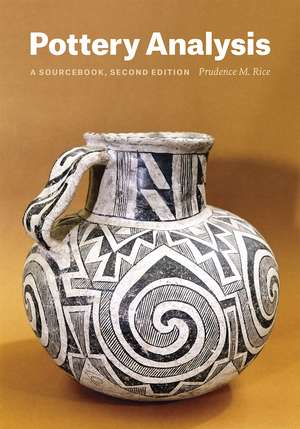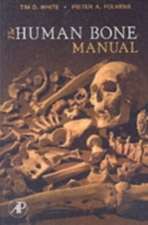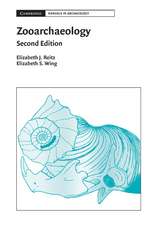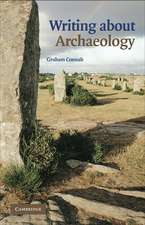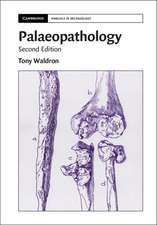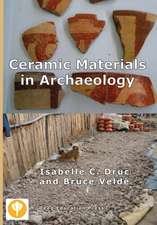Pottery Analysis, Second Edition: A Sourcebook
Autor Prudence M. Riceen Limba Engleză Paperback – 9 iul 2015
Just as a single pot starts with a lump of clay, the study of a piece’s history must start with an understanding of its raw materials. This principle is the foundation of Pottery Analysis, the acclaimed sourcebook that has become the indispensable guide for archaeologists and anthropologists worldwide. By grounding current research in the larger history of pottery and drawing together diverse approaches to the study of pottery, it offers a rich, comprehensive view of ceramic inquiry.
This new edition fully incorporates more than two decades of growth and diversification in the fields of archaeological and ethnographic study of pottery. It begins with a summary of the origins and history of pottery in different parts of the world, then examines the raw materials of pottery and their physical and chemical properties. It addresses ethnographic and ethnoarchaeological perspectives on pottery production; reviews the methods of studying pottery’s physical, mechanical, thermal, mineralogical, and chemical properties; and discusses how proper analysis of artifacts can reveal insights into their culture of origin. Intended for use in the classroom, the lab, and out in the field, this essential text offers an unparalleled basis for pottery research.
This new edition fully incorporates more than two decades of growth and diversification in the fields of archaeological and ethnographic study of pottery. It begins with a summary of the origins and history of pottery in different parts of the world, then examines the raw materials of pottery and their physical and chemical properties. It addresses ethnographic and ethnoarchaeological perspectives on pottery production; reviews the methods of studying pottery’s physical, mechanical, thermal, mineralogical, and chemical properties; and discusses how proper analysis of artifacts can reveal insights into their culture of origin. Intended for use in the classroom, the lab, and out in the field, this essential text offers an unparalleled basis for pottery research.
Preț: 485.07 lei
Nou
Puncte Express: 728
Preț estimativ în valută:
92.83€ • 96.56$ • 76.64£
92.83€ • 96.56$ • 76.64£
Carte disponibilă
Livrare economică 24 martie-07 aprilie
Preluare comenzi: 021 569.72.76
Specificații
ISBN-13: 9780226923215
ISBN-10: 0226923215
Pagini: 592
Ilustrații: 90 halftones, 124 line drawings, 49 tables
Dimensiuni: 178 x 254 x 38 mm
Greutate: 1.05 kg
Ediția:Second Edition
Editura: University of Chicago Press
Colecția University of Chicago Press
ISBN-10: 0226923215
Pagini: 592
Ilustrații: 90 halftones, 124 line drawings, 49 tables
Dimensiuni: 178 x 254 x 38 mm
Greutate: 1.05 kg
Ediția:Second Edition
Editura: University of Chicago Press
Colecția University of Chicago Press
Notă biografică
Prudence M. Rice is distinguished professor emerita in the Department of Anthropology at Southern Illinois University Carbondale.
Cuprins
List of Figures
List of Tables
List of Boxes
Preface to the Second Edition
Preface to the First Edition
Note to Instructors
Part 1 Introduction
1 Pottery and Its History
2 Clays: Origins and Definitions
8 Manufacture
12 Methods and Theories
20 Production I: Location
24 Style and Social Interaction
25.1 Vessel Form, Technology, and Use
26 The Humility of Things
Reference List
Index
List of Tables
List of Boxes
Preface to the Second Edition
Preface to the First Edition
Note to Instructors
Part 1 Introduction
1 Pottery and Its History
1.1 Pottery and Ceramics: Definitions and Products
1.2 The Earliest Pottery
1.2 The Earliest Pottery
1.2.1 Pottery Containers: Why Pots?
1.2.1.1 Hunting-Gathering-Foraging-Collecting
1.2.1.2 Hypotheses and Models
1.2.2 Software
1.3 Pottery and Ceramics in the Old World
1.3.1 Eastern Asia
1.3.2 Western Asia/Near East
1.3.3 Africa
1.3.4 Europe and the Mediterranean
1.3.4 Europe and the Mediterranean
1.4 Pottery and Ceramics in the “New” World
1.4.1 South America
1.4.2 Mesoamerica
1.4.3 North America
1.4.4 Pottery and Ceramics in the Colonial World
Part 2 The Raw Materials of Pottery Making: Perspectives from Chemistry, Geology, and Engineering1.4.2 Mesoamerica
1.4.3 North America
1.4.4 Pottery and Ceramics in the Colonial World
2 Clays: Origins and Definitions
2.1 Earth Materials
2.1.1 Rock-Forming Minerals
2.1.2 Weathering and Clay Formation
2.1.2 Weathering and Clay Formation
2.2 Definitions of Clays
2.2.1 Granulometry
2.2.2 Depositional Situation
2.2.3 Chemical Composition
2.2.4 Mineralogy: Phyllosilicates
2.2.2 Depositional Situation
2.2.3 Chemical Composition
2.2.4 Mineralogy: Phyllosilicates
2.2.4.1 Planar Phyllosilicates
2.2.4.2 Non-planar Phyllosilicates
2.2.4.2 Non-planar Phyllosilicates
2.2.5 Commercial Uses
2.3 Functional Definitions
3 Plasticity: The Clay/Water System3.1 Water, Dipoles, and Ions
3.2 Plasticity
3.2.1 Factors Influencing Plasticity
3.2.1.1 Particle Size and Shape
3.2.1.2 Surface Tension
3.2.1.3 Adsorbed Ions and Rigid Water
3.2.1.4 Clay Mineral Component
3.2.1.5 Deposit Location and Organic Matter
3.2.1.2 Surface Tension
3.2.1.3 Adsorbed Ions and Rigid Water
3.2.1.4 Clay Mineral Component
3.2.1.5 Deposit Location and Organic Matter
3.2.2 Measuring Plasticity
3.3 Ions and Organics
3.3.1 Ions
3.3.2 Flocculation
3.3.3 Organics
4 Non-clay Constituents3.3.2 Flocculation
3.3.3 Organics
4.1 Coarse Inclusions
4.1.1 Three Common Minerals
4.1.2 Triaxial Bodies
4.1.2 Triaxial Bodies
4.2 What Is Temper?
4.2.1 Kinds of Temper
4.2.2 Problems in Terminology
4.2.2 Problems in Terminology
4.3 Distinguishing Naturally Present from Added Substances
4.3.1 Inorganics vs. Organics
4.3.2 Size and Shape
5 Drying and Shrinkage4.3.2 Size and Shape
5.1 Kinds of Water
5.2 Green Strength
5.3 Drying Defects and Causes
5.3.1 Particle Size and Shape
5.3.2 Method of Shaping
5.3.3 Preferred Orientation
5.3.4 Ambient Conditions
5.3.2 Method of Shaping
5.3.3 Preferred Orientation
5.3.4 Ambient Conditions
5.4 Preheating
6 Changes in Clays with Heat6.1 Variables: Time, Temperature, and Atmosphere
6.2 Changes at Low Temperatures
6.2 Changes at Low Temperatures
6.2.1 Loss of Volatiles
6.2.1.1 Water
6.2.1.2 Organics and Impurities
6.2.1.2 Organics and Impurities
6.2.2 Shrinkage
6.2.3 Changes in Clay Minerals
6.2.4 Changes in Inclusions
6.2.3 Changes in Clay Minerals
6.2.4 Changes in Inclusions
6.3 Changes at High Temperatures
6.3.1 Changes in Mineral Constituents
6.3.2 Sintering and Vitrification
7 Glazes6.3.2 Sintering and Vitrification
7.1 Components and Kinds of Glazes
7.2 Colorants
7.3 Firing
Part 3 Behavior: Ethnographic Perspectives on Pottery Making7.2 Colorants
7.3 Firing
8 Manufacture
8.1 Obtaining and Preparing Resources
8.1.1 Distance
8.1.2 Modification
8.1.2 Modification
8.2 Forming: Techniques and Tools
8.2.1 Hand Building and Molding
8.2.1.1 Hand Building
8.2.1.2 Molding
8.2.1.2 Molding
8.2.2 Supports and Rotational Devices
8.2.3 The Potter’s Wheel
8.3 Finishing: Techniques and Tools
8.3.1 Secondary Forming Techniques: Beating and Scraping
8.3.2 Surface Finishing: Smoothing and Texturing
8.3.2 Surface Finishing: Smoothing and Texturing
8.3.2.1 Smoothing
8.3.2.2 Texturing
8.3.2.2 Texturing
8.4 Drying and Preheating
9 Surface Enhancement9.1 Penetration or Displacement
9.1.1 Impressing
9.1.2 Cutting
9.1.2 Cutting
9.2 Additions to the Surface
9.2.1 Appliqués
9.2.2 Color and Colorants
9.2.2 Color and Colorants
9.2.2.1 Painting
9.2.2.2 Slips
9.2.2.2 Slips
9.3 Glaze
10 Firing10.1 Separated Fuel and Ware: Kiln Firing
10.1.1 Types of Kilns
10.1.2 Firing
10.2 Intermingled Fuel and Ware: Mixed Firing
10.2.1 Time, Temperature, and Atmosphere
10.2.2 Postfiring Treatments
10.2.2 Postfiring Treatments
10.3 Economic Realities: Costs and Losses
10.3.1 Problems of Mixed Firing
10.3.2 Problems of Kiln Firing
10.3.3 Fuels and Costs
10.3.2 Problems of Kiln Firing
10.3.3 Fuels and Costs
10.4 Final Considerations
11 Exchange and Household Provisioning11.1 Distribution: From Producer to Consumer
11.1.1 Reciprocity, Redistribution, Exchange, Trade
11.1.2 Costs and Prices
11.1.3 Cautions in Interpretation
11.1.2 Costs and Prices
11.1.3 Cautions in Interpretation
11.2 Consumers: Ceramic Censuses and Household Assemblages
11.2.1 How Many Pots?
11.2.2 Pottery Use-Life
11.2.3 Recycling and Replacement
Part 4 Methods and Measures: Analyzing Archaeological Pottery11.2.2 Pottery Use-Life
11.2.3 Recycling and Replacement
12 Methods and Theories
12.1 Theories and Approaches
12.1.1 Experimental Archaeology and Ethnoarchaeology
12.1.2 Technology and Choices
12.1.3 Behavioral Archaeology and Life Histories
12.1.3 Behavioral Archaeology and Life Histories
12.2 Formation Processes
12.2.1 Discard and Refuse Disposal
12.2.2 Site Assemblages
12.2.2 Site Assemblages
12.2.2.1 Population and Permanence
12.2.2.2 Some Cautions
13 Classification12.2.2.2 Some Cautions
13.1 Attributes
13.2 History of Americanist Pottery Classification
13.3 So, What Are Types?
13.4 Kinds of Classifications
13.4.1 Ethnotaxonomy
13.4.2 Devised or Formal Classifications
13.4.3 Form and Form-Based Categorizations
13.4.2 Devised or Formal Classifications
13.4.3 Form and Form-Based Categorizations
13.4.3.1 Size and Proportions
13.4.3.2 Special Shape Terms
13.4.3.3 Geometric Forms and Contours
13.4.3.2 Special Shape Terms
13.4.3.3 Geometric Forms and Contours
13.5 Why Classify Pottery?
14 Characterization14.1 Historical Background
14.2 Methods
14.3 Research Design: Fieldwork and Field Sampling
14.3 Research Design: Fieldwork and Field Sampling
14.3.1 Excavation Loci
14.3.2 Recovery and Processing
14.3.3 Collecting Resources
14.3.2 Recovery and Processing
14.3.3 Collecting Resources
14.4 Interpretation
15 Quantification and Sampling Collections15.1 Quantification
15.1.1 Counts and Measurements
15.1.2 Statistical Analysis
15.1.3 Sherds to Pots
15.1.2 Statistical Analysis
15.1.3 Sherds to Pots
15.2 Sampling
15.2.1 Sampling Pottery Collections
15.2.2 Selecting Individual Sherds
15.2.3 Sampling for Characterization
15.2.2 Selecting Individual Sherds
15.2.3 Sampling for Characterization
15.2.3.1 Research Question: The Basics
15.2.3.2 Considering Methods
15.2.4 Sampling for Chemical Compositional Analysis
16 Color16.1 Human Perception of Color
16.2 Sources of Pottery Color and Its Variability
16.2 Sources of Pottery Color and Its Variability
16.2.1 Organic Matter
16.2.2 Iron Compounds
16.2.3 Other Colorants
16.2.2 Iron Compounds
16.2.3 Other Colorants
16.3 Measuring Color
16.4 What Are Color Measurements Used For?
17 Mineral and Chemical Composition16.4 What Are Color Measurements Used For?
17.1 Mineral Analysis
17.1.1 Petrographic Characterization
17.1.2 X-Ray Diffraction (XRD)
17.1.2 X-Ray Diffraction (XRD)
17.2 Chemical Analysis
17.2.1 Instrumental Neutron Activation Analysis (INAA)
17.2.2 Laser Ablation–Inductively Coupled Plasma–Mass Spectrometry (LA-ICP-MS)
17.2.3 X-Ray Fluorescence Spectroscopy (XRF)
17.2.4 Proton-Induced X-Ray Emission Spectroscopy (PIXE)
18 Physical and Mechanical Properties17.2.2 Laser Ablation–Inductively Coupled Plasma–Mass Spectrometry (LA-ICP-MS)
17.2.3 X-Ray Fluorescence Spectroscopy (XRF)
17.2.4 Proton-Induced X-Ray Emission Spectroscopy (PIXE)
18.1 Properties, Microstructure, and Stresses
18.1.1 Microstructure
18.1.2 Physical and Mechanical Stresses
18.1.2 Physical and Mechanical Stresses
18.2 Hardness and Strength
18.2.1 Hardness
18.2.2 Strength
18.2.2 Strength
18.3 Permeability and Porosity
18.3.1 Pores
18.3.2 Permeability
18.3.3 Porosity and Density
18.3.4 Additional Considerations
18.3.2 Permeability
18.3.3 Porosity and Density
18.3.4 Additional Considerations
18.4 Cracks and Failure
18.5 Relations to Use
19 Thermal Behavior18.5 Relations to Use
19.1 Thermal Properties
19.2 Thermal Stresses and Shock
19.3 Stress and Shock Resistance
19.3.1 Intrinsic Properties
19.3.2 Microstructure
19.3.3 Shape and Design
19.3.2 Microstructure
19.3.3 Shape and Design
19.4 Modifying Thermal Behavior
Part 5 Research Questions and Problems: Interpreting Archaeological Pottery20 Production I: Location
20.1 Physical Indicators
20.1.1 Artifactual Indicators
20.1.2 Spatial Indicators
20.1.2 Spatial Indicators
20.2 Provenience/Provenance
20.2.1 Compositional Analyses
20.2.2 Confounding Factors
20.2.2.1 Analytic Confounding Issues
20.2.2.2 Behavioral Confounding Issues
21 Production II: Organization20.2.2 Confounding Factors
20.2.2.1 Analytic Confounding Issues
20.2.2.2 Behavioral Confounding Issues
21.1 Mode, Scale, and Intensification
21.1.1 Mode of Production
21.1.2 Scale of Production
21.1.3 Intensification and Specialization
21.1.4 Mode, Scale, Intensification, and Complexity
21.1.2 Scale of Production
21.1.3 Intensification and Specialization
21.1.4 Mode, Scale, Intensification, and Complexity
21.2 Specialization
21.2.1 Types and Models of Specialized Production
21.2.1.1 Producer Specialization
21.2.1.2 Community Specialization
21.2.1.3 Resource Specialization
21.2.1.4 Product Specialization
21.2.1.2 Community Specialization
21.2.1.3 Resource Specialization
21.2.1.4 Product Specialization
21.2.2 Multicrafting
22 Production III: The Products22.1 Attribute Variability and Specialization
22.1.1 Standardization
22.1.2 Diversity
22.1.2 Diversity
22.2 Commodities and Commodification
22.2.1 Commodification
22.2.2 Commodities and Trade
22.2.2 Commodities and Trade
22.3 Final Observations
23 Archaeothermometry23.1 Physical Properties
23.2 Mineralogical and Chemical Analyses
23.2.1 Microscopy
23.2.2 Thermal Methods
23.2.3 X-Ray Diffraction
23.2.4 Mössbauer Spectroscopy
23.2.5 Magnetic Properties
23.2.6 Fourier Transform Infrared Spectroscopy (FTIR)
23.3 Some Cautions23.2.2 Thermal Methods
23.2.3 X-Ray Diffraction
23.2.4 Mössbauer Spectroscopy
23.2.5 Magnetic Properties
23.2.6 Fourier Transform Infrared Spectroscopy (FTIR)
24 Style and Social Interaction
24.1 What Is Style?
24.2 What Does Pottery Style Do?
24.3 Archaeological Approaches to Pottery Style
24.3 Archaeological Approaches to Pottery Style
24.3.1 Design Elements and Social Interaction
24.3.2 Hierarchical Design Structure Analysis
24.3.3 Symmetry Analysis
24.3.2 Hierarchical Design Structure Analysis
24.3.3 Symmetry Analysis
24.4 Style as Communication
24.4.1 Information Theory
24.4.2 Active or Passive?
24.4.3 Learning/Transmission
24.4.4 Visibility
24.4.5 Meaning
24.4.2 Active or Passive?
24.4.3 Learning/Transmission
24.4.4 Visibility
24.4.5 Meaning
24.5 Further Developments
24.5.1 Theoretical Contexts
24.5.2 Style Change
24.5.3 In Sum . . .
25 Functions and Forms24.5.2 Style Change
24.5.3 In Sum . . .
25.1 Vessel Form, Technology, and Use
25.2 Indirect Evidence and Inferred Functions
25.2.1 Physical Attributes
25.2.2 Forms and Functions
25.2.3 Functions and Forms
25.2.2 Forms and Functions
25.2.3 Functions and Forms
25.2.3.1 Storage
25.2.3.2 Cooking
25.2.3.3 Transfer
25.2.3.2 Cooking
25.2.3.3 Transfer
25.3 Direct Evidence of Use
25.3.1 Residues: Identification of Contents
25.3.2 Sooting
25.3.3 Surface Attrition
25.3.3 Surface Attrition
25.4 The Hegemony of the Cookpot
Part 6 Then and Now; Now and Then26 The Humility of Things
26.1 The Humility of Pottery
26.2 From Today to Yesterday
26.2.1 Change: The “Arts of Acculturation”
26.2.2 Decoration and Style
26.2.3 Form and Function
26.2.4 Production and Distribution
26.2.2 Decoration and Style
26.2.3 Form and Function
26.2.4 Production and Distribution
26.3 From Today to Yesterday: Some Questions
26.3.1 Status
26.3.2 Commodification and Specialization
26.3.2 Commodification and Specialization
26.4 Change and Conservatism
GlossaryReference List
Index
Recenzii
“Although it is of special interest to archaeologists, Rice’s compendium is also directed toward a wider audience, including social, physical, and materials scientists. Her broad work provides both an introduction to the topic and an exceedingly valuable asset to the most advanced researcher. . . . Rice’s excellent volume is a true sourcebook and will serve as the standard for many years to come.”
“A highly ambitious, well-organized, encyclopedic reference manual conceived on a broad scale and provides a holistic coverage not found in any other volumes.”
“Rice has produced a magnificent synthesis that belongs on every archeologist's shelf. It is also an excellent textbook for students.”
“This is the book that all of us interested in ceramic analysis wish we had written. Rice has written a well-organized and comprehensive review of the breadth of research being done in the field of ancient ceramic technology and vessel function, from design analysis to the latest advances in provenience studies in a framework where understanding the potter and the potter's socioeconomic milieu is the paramount objective.”
“As a reference work about contemporary ceramic research, it can only be described in superlatives. Rice summarizes nearly everything happening in the study of ceramics today. Scholars and students alike will find something in the book related to their interest. . . . An important book.”
